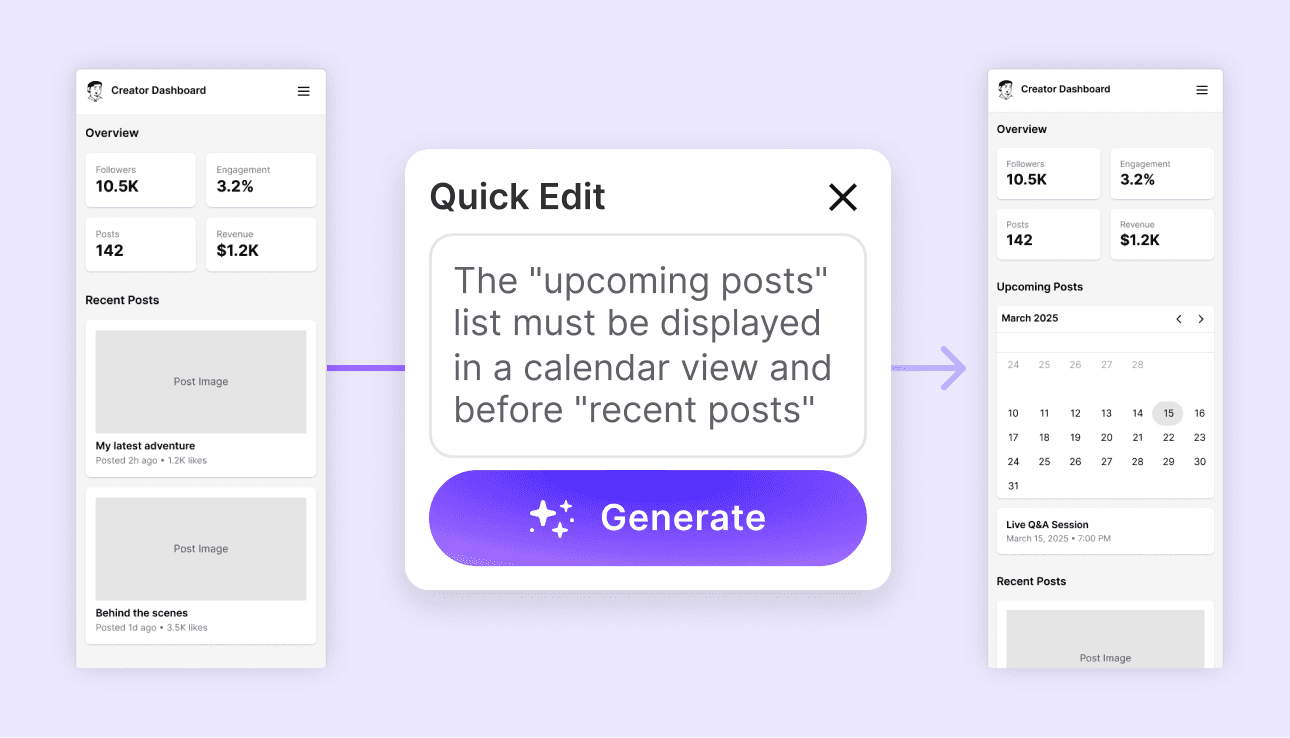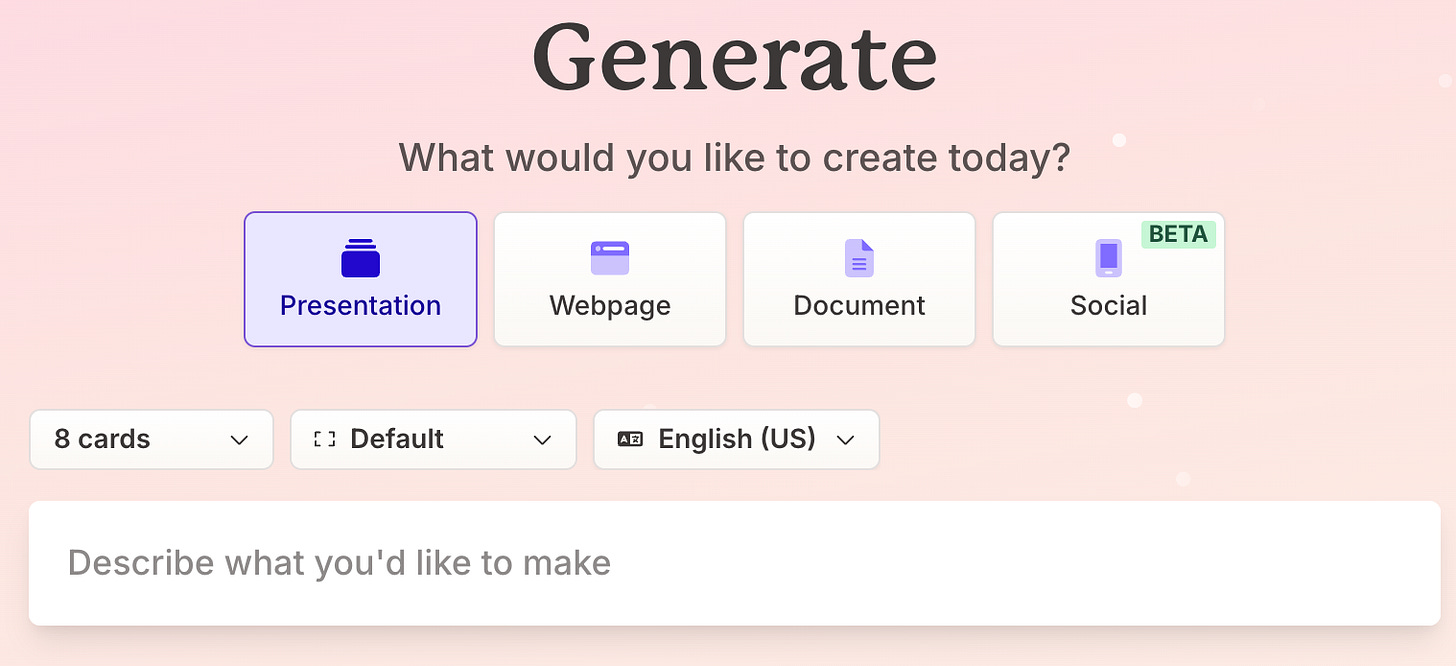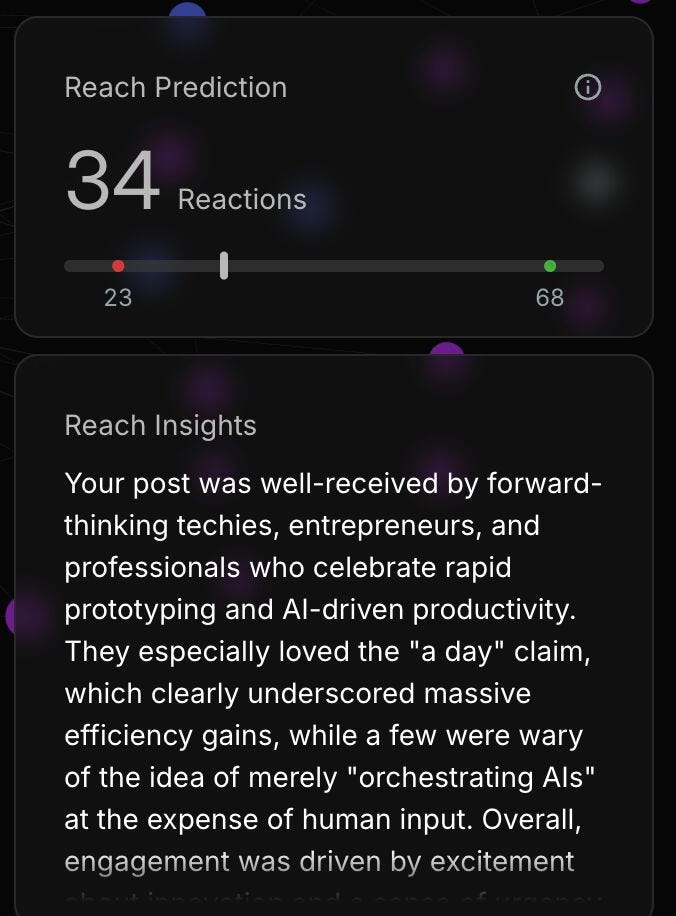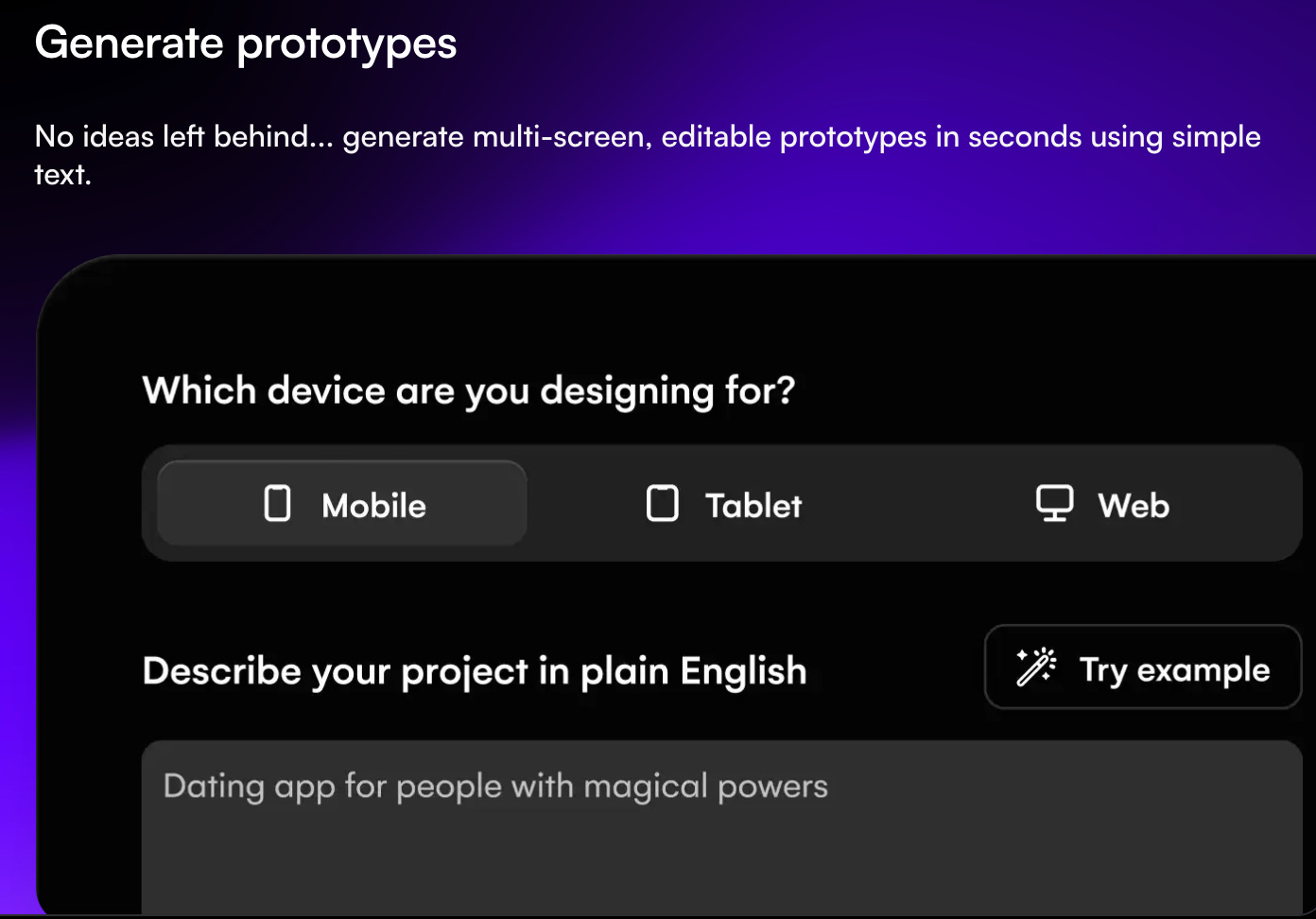7 AI Tools Saved Me 2 Weeks of Work in a 3-Day Sprint
A detailed breakdown of how I used AI for ideation, customer discovery and prototyping this week.
This week I teamed up with an experienced entrepreneur to explore a number of business ideas for their company. We had a 3-day sprint making more progress than either of us expected thanks to using AI tools at every opportunity. Without AI tools, it would have taken me about 2 weeks, if not more.
Here’s exactly how you can replicate my AI workflow to rapidly validate ideas without wasting time.
The Brief
Our plan was to start investigating a high-level idea that we already had and depending on what we would learn, maybe pivot in a new direction.
Crucially, it was important to make sure that the ideas we were working on were AI-first ideas. That is, they would directly leverage the growing power of artificial intelligence models to make sure that the product effortlessly improves as AI gets stronger. I explain why this is so important in this essay.
Day 1: Research and Customer Development
Tool: OpenAI Deep Research
Process: Use ChatGPT 4o to craft a detailed research prompt, then give it to Deep Research, get about 10,000 words of output back. Read slowly, check references, draw conclusions.
Impact: Deep Research is the single most important tool in this process1, helping me quickly get a deep insight into an area I might not know. Without DR I would have spent hours or days getting the same information. (Here’s a great reflection on big implications of Deep Research for venture investing.)
Tool: Granola
Process: I did several customer development interviews over whatsapp calls using Granola to write notes. It’s not a transcriber. It listens to the calls and writes the notes I would have written myself, highlighting what was important. Every time I asked for permission to use Granola2 and in all but one case the person said yes. So for one person, I wrote the notes manually.
Impact: I probably saved 15 minutes per call on notes. Instead, I wrote comments on specific parts of notes to highlight some fine points.
Tool: Claude
Process: To prepare for the interviews, I asked Claude to give me a script for customer development for this particular product idea using best practices from The Mom Test.
Impact: Saved me 20-30 minutes. Could I have done it myself? Sure. But I’m happy I didn’t have to.
Tool: Wispr Flow
Process: Talk to the computer instead of typing text. This is faster and often easier, but it requires forming a sentence in my head before speaking it. Alternatively, I can just speak freely without trying to be coherent and then ask a ChatGPT model to make sense of it.
Impact: It saved a little bit of time as I was writing my final two-pager to summarise findings of the day. It saved more time when I was using it to give unstructured ideas off the top of my head to ChatGPT or Claude.
🤓Azeem Azhar just wrote a great essay on "vibe working" which describes this mindset shift. I recommend you read it.
Tool: Google Gemini
Process: I needed to build a sophisticated financial model to quickly assess if a specific idea is viable, without spending a day building it manually. So I asked Google Gemini to help me build the model, hoping that it would also help me create it in Google Sheets, as both are Google products and are integrated in theory.
In practise, it didn't work well. It explained in detail how to build a complex financial model for this particular product, but it absolutely failed at making it work in Google Sheets.
Impact: I probably wasted at least half an hour, if not an hour, trying to make it work before realising that it's just too much time and I should give up for now.
Tool: Claude
Process: Since Google Gemini could not build me a financial model in Google Sheets, I asked Gemini to prepare a detailed prompt for Claude to build this tool as an artefact, effectively, building me a small website that would model all the parameters instead of using Google Sheets or Excel. It didn't work out. Claude tried several times, and it failed to build it due to its complexity.
Impact: I wasted maybe another half an hour.
Tool: Claude
Process: I asked Claude to build me a prototype of the product just to get a sense of what it could look like. It wasn't particularly impressive or sophisticated, but it was also easy to do, and so I did it.
Impact: Spent 10-15 minutes and clicked around a basic prototype, but it wasn’t transformational.
Tool: Deep Research
Process: I have a thesis that AI-first startups that effortlessly leverage the power of LLMs, allowing the product to get better while the owner sleeps, will outperform regular startups. (I explained why here.) I used Deep Research to brainstorm how we can use AI-first thinking for this particular idea I was working on to make sure that the product we are creating is truly AI-first.
Impact: Better, deeper, faster thinking about one of the key questions that was facing me this week.
By the end of Day 1, we concluded based on research and customer interviews that the original idea is a dead-end and identified a possible pivot based on what we learned from the customers.
🚀 Is this post useful? Forward it to your colleagues now.
Day 2: Pivoting and Prototyping
Tool: Claude
Process: I woke up to read the news that Claude 3.7 is out, apparently much better than the version 3.5 I was using the day before. I took exactly the same prompt that Claude was failing at the day before and gave it to the new version of Claude to get the financial model. Twenty seconds later I get a sophisticated working app with a complex financial model inside giving me exactly what I needed!
It's still about 06:30 am, I even haven't had my coffee yet. 🤯
Impact: The financial model that Claude built confirmed my intuition that this particular idea is not viable financially. I suspected it yesterday based on my research, and now I had a confirmation from a financial model.
However, given its complexity, I wouldn't trust it for a real case without inspecting the code, and that would effectively mean rebuilding it myself in Excel if I were serious about it. But given that it aligns with my intuition… I chose to trust it.
Tool: OpenAI Deep Research
Process: We're back into research mode with Deep Research. I give it names of several competitors as well as my thoughts on approaching this problem from an AI-first perspective and ask it to help me think through solving this problem in an AI-first way. It produces very high-quality research which gives me an idea of how to solve this problem and what a product could look like.
Impact: Saves me a lot of time, gives me ideas.
Tool: UXPilot
Process: I had a sense of what kind of wireframes I wanted to build, but I didn't want to do it manually, so I started looking for an AI tool that I could just talk to to explain what kind of wireframes to build for me. I haven't used UXPilot before, and Figma AI is not available on my account yet, so I started with UXPilot.

Impact: I wasted quite a bit of time with UX Pilot trying to make it work, but eventually realised that it would be faster if I did it myself because it was too cumbersome. I'm sure it's going to be great very soon. This is very obviously the future, but it didn't work, so instead I went and used Balsamiq (that's been around for 20 years).
Tool: Replit Agent
Process: Now that I had a good description of the prototype I wanted to be built as well as some wireframes, I went to Replit, gave it the description and one wireframe as an example, and it produced a basic working prototype. Even integrated with OpenAI API so I could chat to it.
Impact: Was fun to click around; it took about ten minutes to build anyway. Not sure I learned much in the process.
Tool: Gamma
Process: Just for fun, I asked Gamma to create a 10-slide pitch deck for this product as if we were fundraising. I gave the idea to Gamma, and 20 seconds later, I got the pitch deck. It wasn't really ready to go and raise funding just like that, but for a few minutes of work, it was fun to see it.
Impact: No impact really. I wouldn't have built it myself if I didn't have Gamma to do it. Here, it's interesting that AI enables me to quickly do something that I might have as an idea in my mind, but I wouldn't be bothered to build it.
Tool: Societies.io
Process: I was pretty proud of the progress I was making, so I wrote a quick LinkedIn post about it. But before publishing it, I ran it past the model at societies.io to get a prediction of how my audience would respond to it.
Societies.io creates a synthetic version of my LinkedIn audience, giving me an idea of how well my posts will do before I publish them. For this particular post, they predicted 34 reactions, which actually turned out to be only about half of what I actually got on LinkedIn.
Impact: None really, but Societies.io is also offering a tool to create a synthetic version of investors, which would be useful if I were fundraising right now. It's currently building the same for product-market fit, and I'm very much looking forward to that one. If they don't release it soon, I'll build it myself to be able to show my ideas to a synthetic version of a potential audience, alongside talking to real people for customer development.
Tool: Deep Research
Process: Every community forum with a lot of users trying to solve their problem is an AI-first solution looking to be born. I used Deep Research to analyse a few popular community forums in a specific niche to identify their weaknesses and surface opportunities for building an AI-first solution using LLMs.
Impact: It gave us a direction going forward, refining the idea.
By the end of day 2 we had a far stronger idea than when we started, a set of learnings from real users, a set of wireframes we liked and a hypothesis of how this will leverage AI in an AI-first way. We decided to refine the idea the next day by building more refined wireframes and a financial model.
Day 3: Financial modelling and more wireframing
Process: UXPilot didn't work for me the day before, and generally visual design is really not my strength, so I didn't want to waste a half day fiddling around with UI elements.
Instead, I asked several LLMs (ChatGPT, Claude, Grok) to give me a very specific description of what the wireframes should look like based on my ideas of the app that I wanted to build. Grok produced the best output.
With a much more specific idea of what it should look like thanks to Grok, I tried a new tool - Uizard to build and refine wireframes. Like UXPilot, Uizard generates high-fidelity wireframes based on text prompts but also allows you to modify them manually or using AI depending on the situation.
Impact: Through a combination of AI building and manual adjustment, I built a much more specific set of wireframes for the product. Saved a lot of time.
Tool: Gemini
Process: Then I needed to build a financial model, remembering that Gemini was not going to do it automatically for me (I’m sure it will in a few months or a year). I asked it to help me think through how to build it, and then build it manually in Google Sheets.
Impact: Saved, maybe, an hour.
At the end of day three we were quite happy with the idea we had (AI-first, backed by our research and customer insights, with a basic financial model showing its viability, wireframes and a basic prototype), but we still had a couple hours left.
We decided to take a look at an idea that’s been on the backburner for a long time. I knew exactly nothing about the problem space when I started. Thanks to Deep Research, an hour and a half later, I could articulate in detail what’s the problem, why it exists, how different teams have been trying to solve it using AI and why we shouldn’t bother.
Without Deep Research that would have taken at least a day if not two. In particular, it was helpful to ask AI to explain scientific articles to me to surface insights I needed.

The Results
It was a lot of fun! It reminded me of Startup Weekends I used to run 15 years ago when in a space of two days small teams would come up with ideas, build prototypes, do customer development and validate their assumptions before building a demo by Sunday night.
This week, we went from an idea through two pivots supported by a lot of research, financial modelling, wireframing and prototyping in just three days.
Without AI? It would have been 2 weeks and way less fun :)
🚀Interested in running your own rapid AI-powered ideation sprint?🚀
There are rumours on Twitter that Perplexity’s version isn’t too shabby either, but I’m yet to try it. This field moves so fast!
Since Granola doesn’t identify itself to the other party in any way and it’s VERY popular, assume that every call you’re on, including whatsapp calls, is transcribed and recorded. But, the right thing to do is to always ask for permission.









Hey Evgeny,
Thanks for sharing - really like the breakdown of how you integrated AI tools into a sprint. A few thoughts and questions came to mind:
- Claude vs. ChatGPT – Curious about your experience using Claude vs. ChatGPT in practice. From what I’ve read, aside from differences in training data and methodology, Claude seems slightly more nuanced and conversational but not dramatically different in output. Has it noticeably outperformed ChatGPT for you in certain cases?
- AI Tool Discovery – When it comes to discovering new AI tools, do you rely mostly on DeepResearch/ChatGPT (or other sources) to surface and assess tools? Would be great to hear if you have a go-to process for filtering.
- Customer Insights – DeepResearch and Societies.io seem like the most impactful tools from your list. I was wondering if you considered leveraging others in your sprint—were there any that didn’t make the cut, and if so, why?
Love this. Thanks for the detailed breakdown.
Obviously I'm shilling my own idea here, but I'm curious as to the level of trust that you place in Deep Research when it comes to such a big decision like stop/go on a start-up idea.
Did you share your deep research chat with someone with domain expertise to get their 15-minute input on a) your prompt and b) the highest signal part of its answer?
Imho, this would be v valuable and will become an increasingly common way of working
(more on why here: https://thefuturenormal.substack.com/p/chatgpts-deep-research-and-thinking)